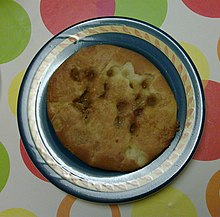Sugar pie

Sugar pie from northern France
|
|
| Alternative names | Sugar cream pie, Hoosier sugar cream pie, Indiana cream pie, Indiana farm pie, finger pie, tarte au sucre |
|---|---|
| Type | Pie |
| Main ingredients | Flour, butter, vanilla, cream |
| |
|
Sugar pie is a typical dessert of the western European countries of Northern France and Belgium, the Canadian province of Quebec, and Midwestern United States states such as Indiana, where it is known as sugar cream pie (other names are Hoosier sugar cream pie, Indiana cream pie, Indiana farm pie, and finger pie).
Sugar pie is a single-crust pie with a filling made from flour, butter, salt, vanilla, and cream, with brown sugar or maple syrup (sometimes both) often used as additional filler. When baked, these ingredients combine into a homogeneous mixture similar to caramel. If maple syrup is used, it might be referred to as maple pie. The European version is vaguely reminiscent of an American "transparent pie" (the name in the Midwestern and Southern United States for a version of pecan pie without the pecans), of English Canadian butter tarts, or of English treacle tart.
The ideal sugar cream pie is supposed to be like Santa Claus in that it should shake "like a bowl full of jelly." The name "finger pie" for the dessert was due to stirring the pie during baking with one's finger. It was stirred this way to avoid breaking the crust.
The Indiana version of a sugar pie, known as "sugar cream pie", is believed to have originated with Quaker settlers who came from North Carolina in the early 19th century, and thereafter settled in east-central Indiana, particularly around the cities of New Castle, Portland, Richmond, and Winchester.
The Amish also popularized sugar cream pie, making the pie easy to find where they populated. In particular, the pie is a favorite in the Pennsylvania Dutch areas, much as is shoofly pie, a similar dessert. Shakers also have a variant of the pie. However, as the Shakers had to abandon their community of West Union (Busro) (near modern-day Vincennes, Indiana) in 1827, their only presence in Indiana ever (1810–1827), it is unlikely that they made the dessert popular in the state.
...
Wikipedia
